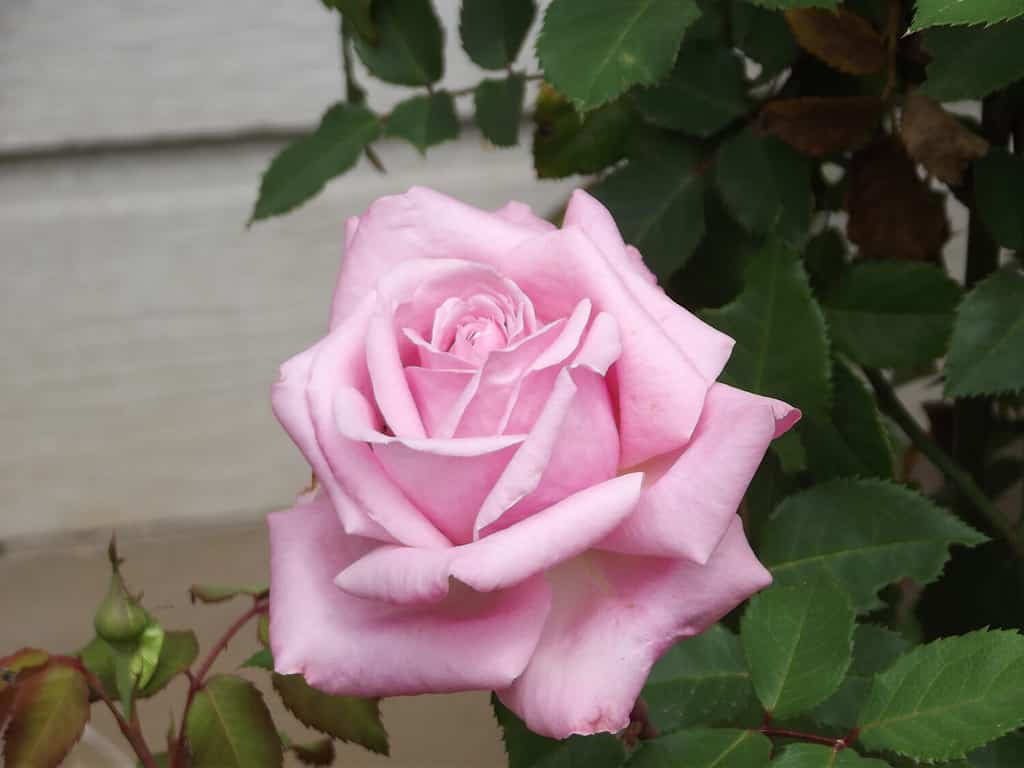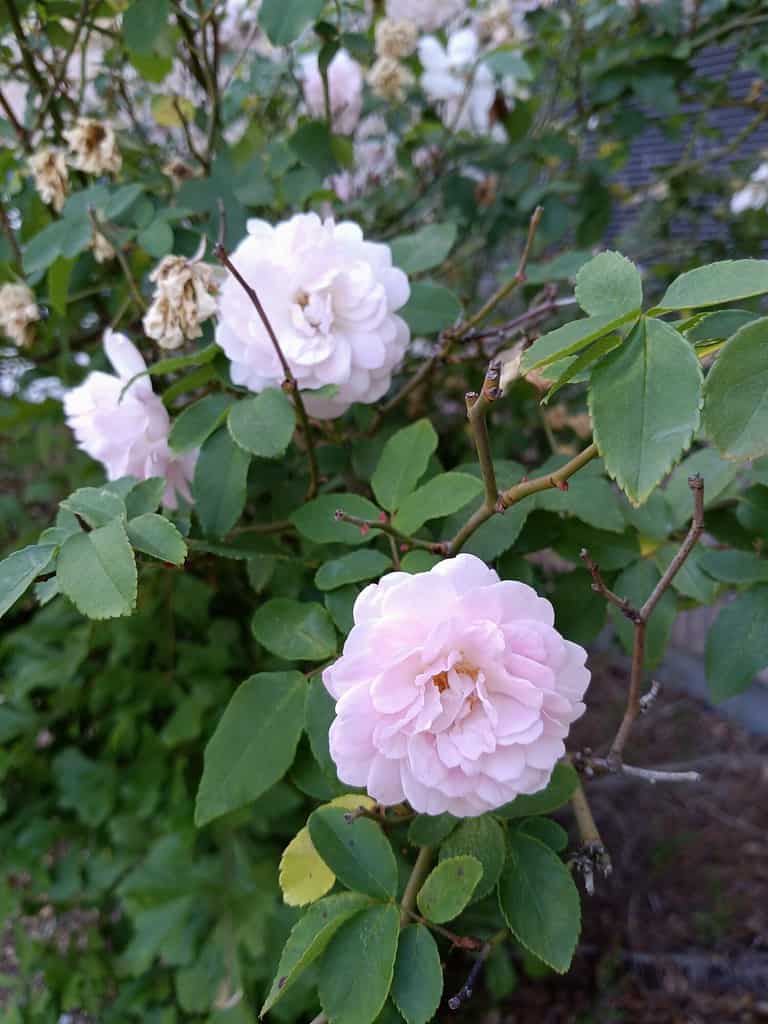Growing roses in Texas can be a challenge. The hot summers and dry air can quickly desiccate an otherwise happy, healthy rose bush. In many parts of the state, the soil is notoriously alkaline and not conducive to their growth.
If you’re new to rose gardening or have struggled to grow roses in the past, you should consider planting Earth-Kind roses in your garden. These low-maintenance cultivars have been proven to grow well throughout the state of Texas, making them good choices for rose gardeners of any skill level. In addition to their ease of care, they require very few resources and can thrive in a variety of growing conditions that other roses might struggle with.
What is an Earth-Kind Rose?
For eight years, a multidisciplinary team of scientists at the Texas A&M AgriLife Center ran dozens of rose cultivars through a gamut of field trials. These trials tested the roses’ abilities to resist pests and disease and withstand minimal input conditions in the garden environment. Throughout the trials, the plants received no pesticides or fungicides, organic or inorganic. After the trials concluded, the results passed through a 14-member advisory panel consisting of research personnel, industry representatives, and professional rosarians.
Roses that earned the Earth-Kind designation after deliberation have proven themselves to be exceptionally hardy and well-rounded cultivars. Each one displayed excellent drought tolerance and the ability to thrive in a variety of soil conditions. They also exhibited strong, natural resistance to pests and diseases that commonly affect roses. Their limited needs in cultivation prove that they are the least resource-intensive and most environmentally friendly roses to grow at home.
5 Earth-Kind Roses for Texas Gardens
Below, we’ll talk about five of our favorite Earth-Kind cultivars that have proven themselves to be some of the best roses for Texas gardens. The same qualities that make them environmentally friendly choices also make them great for beginner rose gardeners.
Rosa ‘Cécile Brünner’
Cécile Brünner is an old-time cultivar with origins dating back to the late 1800s. This climber produces plentiful and delicate pointed blooms along its long, robust stems.
This cultivar is free-blooming and produces dense flushes of flowers for many weeks beginning in the late spring. Each fragrant, fully double flower measures, on average, one and a half inches across and is gentle, pale pink. They are great for cutting and have seen many celebratory uses since their rise to fame in the Victorian Era.
Although it grows best with access to full sun and fertile soil, Cécile Brünner isn’t overly picky. Plants of this cultivar will happily set root in poor soils and partial shade. Not only is this cultivar versatile in its growing conditions, but it also shows strong, natural resistance to disease when cared for properly.
Plant this rose along fences, trellises, or pergolas. Because they can grow to 6 feet wide, be sure to give about 8 feet of space in between each plant. Wide spacing allows for good airflow to all parts of the plant and therefore provides a boost to your plant’s resistance to fungal infections.

Cécile Brünner is a climbing
hybrid tea rose
that has been a beloved flower for generations. It has truly stood the test of time, performing extremely well in Earth-Kind testing.
©J Elliot/Shutterstock.com
Rosa ‘Knock-Out’
True to its name, this rose is not only gorgeous but extremely tough as well. It’s far and away one of the best roses for Texas gardeners of any skill level.
Knock-Out appeared on the scene in the year 2000 and immediately garnered awards for its ease of care. This extremely low-maintenance cultivar exhibits very strong disease resistance, good drought tolerance, and self-cleaning. It can tolerate varying levels of salts in irrigation water and thrives in all but the very hottest of the USDA zones throughout the state.
Beginning in the summer and continuing throughout the fall, Knock-Out produces an incredible number of deep red blooms in overlapping flushes. The flowers, although not fragrant, make stunning additions to bouquets and multi-flower arrangements.
The shrub itself grows, on average, to heights and widths of about 6 feet and should be spaced 8 feet apart from other roses to allow for good airflow in between plants. When choosing a planting site, you’ll want to focus on locations that receive full sun. Although Knock Out can handle some light shading during the afternoon hours, it will produce the most blooms and best foliage when it has access to plenty of sunlight.

The punchy, cherry-red blossoms of this Knock Out cultivar make a huge impact in any garden. Its extremely low-maintenance nature makes it great for gardeners with busy schedules.
©Molly Shannon/Shutterstock.com
Rosa ‘The Fairy’
Topping out at about 3 feet in height, The Fairy is a particularly compact variety of roses. While it is great for planting in the garden bed, this cultivar is also a great choice for growing in a container.
Beginning in the spring, this flower powerhouse produces an abundance of small, one-inch-wide, double blooms that continue to appear until the first frost. In addition to the longevity of its blooming period, this cultivar performs well in the Texas heat. When exposed to high temperatures, its dainty, pink blossoms tend to become blush-white.
The Fairy does best in a full-sun planting site and, like other Earth-Kind roses, prefers good air circulation to help keep its foliage healthy. Once this cultivar has been established for a month or so, it will have better drought tolerance and require only average amounts of water throughout the heat of the summer.
To conserve water and help your roses better stand the summer heat, you should dress the top of their bed with a 3-inch-deep covering of mulch. Not only does this help the soil retain water, but it also insulates the soil against high temperatures. This summer cooling effect can be extremely beneficial for roses in Texas gardens.

This diminutive cultivar stands up to strong sunlight and powers through the Texas heat with grace.
©Marina Rose/Shutterstock.com
Rosa ‘Belinda’s Dream
This mid-size shrub rose is an in-house special, developed by a Texas A&M professor of mathematics. Belinda’s Dream is an excellent example of an Earth-Kind rose and was the first cultivar to receive the distinction.
Belinda’s Dream is a beautiful rose with many applications in the garden. It is a wonderful specimen to grow as a hedge or plant along a fence line. Throughout the spring, summer, and fall, it produces repeat flushes of fragrant, double blooms up to 4 inches in diameter. The petal density of each flower is truly impressive, with some flowers having upwards of 100 petals.
With its origins rooted in the state, it should come as no surprise that Belinda’s Dream is one of the best roses for Texas gardens. It’s truly Texas tough. While it displays outstanding heat tolerance, it can also withstand cold winter temperatures. It grows in a variety of soil conditions, tolerates short periods of drought, and displays strong disease resistance and tolerance. That’s right, tolerance. Belinda’s dream is, like other roses, still susceptible to blackspot when the weather remains damp for long periods. This cultivar generally shrugs it off with ease, however, continuing to thrive and produce its gorgeous blooms.

©Excelementals/Shutterstock.com
Rosa ‘Marie Daly’
Marie Daly is another Texas-born rose cultivar. It is a sport, or habit-changing genetic offshoot, of the very popular old-garden cultivar ‘Marie Pavie’. The originally found specimen was not cultivated intentionally but rather occurred as a happy accident.
The cultivar, like The Fairy, is a low-growing shrub that tops out around 3 feet in height. It does a wonderful job filling similar roles in the garden. Mass plantings, short hedgerows, and container plantings all suit this variety very well. It has very few thorns and performs well when planted along walkways and high-traffic areas. Whenever you choose to plant it, make sure that you give it plenty of room for airflow.
The blooms of Marie Daly are semi-double, displaying moderate petal density when compared to single and double-bloomed varieties. The cultivar is a repeat bloomer, producing its many fragrant, light-pink flowers in successive flushes from late spring until the fall. Because of its low thorn density, pruning and deadheading this cultivar is an absolute breeze.
One of the most celebrated characteristics of this cultivar is its resistance to pests. Even with plenty of airflows, when leaves are consistently dry, Marie Daly rarely suffers from spider mite infestations. Its preference for airy conditions also bolsters its natural resistance to fungal diseases and makes it a perfect choice for any Texas rose garden.

Like The Fairy, this beautiful rose variety turns blush-white when exposed to intense summer heat.
©lumachina_99/Shutterstock.com
The photo featured at the top of this post is © Fabrizio Guarisco/Shutterstock.com
Thank you for reading! Have some feedback for us? Contact the AZ Animals editorial team.







